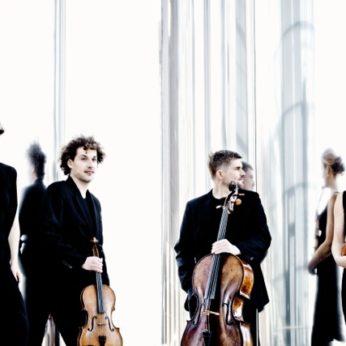Composer: Jörg Widmann (b. 1973)
Performance date: 27/06/2015
Venue: St. Brendan’s Church
Composition Year: 2003
Duration: 00:10:58
Recording Engineer: Richard McCullough, RTÉ lyric fm
Instrumentation: 2vn, va, vc
Instrumentation Category:String Quartet
Artists:
Signum Quartet (Kerstin Dill, Annette Walther [violins], Xandi van Dijk [viola], and Thomas Schmitz [cello]) -
[quartet]

Jörg Widmann is one of the most prominent
living composers today, having already served as composer-in-residence for the
Schleswig-Holstein and Lucerne Festivals, the Cleveland Orchestra, Vienna
Konzerthaus and the West Cork Chamber Music Festival. Widmann, a world class
clarinetist, is also deeply passionate about chamber music and will collaborate
this season with the Hagen, Arcanto and Minguet Quartets, with Tabea
Zimmermann, Antoine Tamestit and Francesco Piemontesi.
Widmann’s Jagdquartett (‘Hunt’
Quartet) is the third in a five-part string quartet cycle; this middle work is
the climax and most idiosyncratic of the series. It begins by quoting romantic
composer Robert Schumann’s Papillons Op.2 and quickly dissolves into an
avant-garde take on the tale of the hunt. This high energy piece represents the
fast movement of the cycle, the Scherzo.
Whereas Mozart’s Hunt Quartet painted a joyful outing in the country and
the gaiety of the sport, Widmann’s Hunt Quartet seeks the thrill of the
kill.
The piece begins with a cry from the
quartet: the chase is on! The last variation from Schumann’s Papillons is
played brutally and with different stages of recognition, often slipping into a
shrieking ponticello or glissando with occasional vocal
interjections from the quartet. At first the four parts seem to ebb and flow
together, slithering in pursuit of their prey, but the jig from Papillons
fades to a distant memory as one travels deeper into the dark forest of
Widmann’s imagination. Melody has been replaced with an exploration in soft,
scratchy strokes that culminate into a series of screams from the quartet and
then the lagging shouts of the cellist. Suddenly, one realizes the cellist has
gone from hunter to hunted. The tension is palpable as the upper
strings quietly surround their victim and a guttural wail from the cellist
signals that dinner is served.
Copyright © 2025 West Cork Music. All rights reserved.
Designed and developed by Matrix Internet